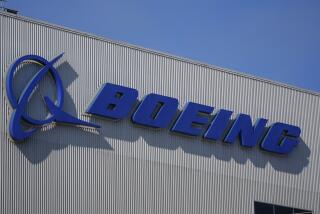Airline’s Unions Far From United Behind Pilots’ Bid
- Share via
If it succeeds, the $6.75-billion bid by United Airlines’ pilots and management to buy their parent firm, UAL Corp., would represent a significant victory for organized labor--but United’s two other major labor unions remain skeptical of the deal.
And that has revealed divisions within United’s labor force and given the lie to the idea that the labor movement is a monolithic force.
“(The Air Line Pilots Assn.) has spent two years trying to put this deal together. . . . And I suspect that there are a number of people who feel that they’re getting it crammed down their throats,” an official at one United union said.
The airline’s largest and most militant union, the International Assn. of Machinists, representing about 23,000 United mechanics, helped block an earlier buyout attempt by the pilots and has said it opposes the idea of employee ownership.
Machinists’ officials have argued that the proposed deal would burden the company with debt.
Will Go Ahead Without Support
Meanwhile, officials of the Assn. of Flight Attendants, representing about 14,000 workers, continue to negotiate with United managers on their possible participation in any employee stock ownership plan. So far, they have taken no formal position on the deal.
For its part, the Air Line Pilots Assn., working on behalf of 7,000 United pilots, plans to go ahead with the deal whether the other unions support it or not. “The deal has always been predicated on the philosophy that the flight attendants and the mechanics are not part of the deal,” said ALPA spokesman Hank Krakowski, who is both a pilot and a licensed aircraft mechanic. “We’re on record welcoming and encouraging the flight attendants and mechanics to join us, but we’re prepared to move ahead without them.”
The division could be seen as a showdown among unions representing labor’s several factions, each with divergent traditions and agendas: the traditional, militant blue-collar union, the female-dominated service workers union and the white-collar professional association that has traditionally allied itself more with management than with labor.
In the beginning, pilots “considered themselves to be a cut above the rest of the employees and considered themselves to be professionals, like doctors,” said Frank A. Spencer, emeritus professor of transportation and industrial labor relations at Northwestern University. “They didn’t want to be considered a union, even though they were one,” he said.
At United, it was not until the divisive strike of 1985 that pilots “got religion,” said the United union official, who asked not to be identified.
Some observers argue that the division over the proposed buyout also reflects historic antagonisms among the unions.
“One of the problems is a longstanding ill-feeling between pilots and machinists,” said Audrey Freedman, a labor economist with the Conference Board in New York. “In the past, the pilots have gone to work when the machinists were on strike . . . and the machinists may feel that they’re not really dealing with union types,” she added.
Created in Conflict
Machinists, citing a no-strike clause in their contract, did not support the 1985 strike by United pilots.
The flight attendants union was created in a conflict with pilots. Once a part of the pilots’ union, the flight attendants split off in the 1970s as the women’s movement heated up, as jumbo jets required larger in-flight crews and as flight attendants felt that the male-dominated pilots’ union was giving them short shrift.
Flight attendants have generally been more supportive of pilots than have machinists. They walked out in support of United’s pilots in 1985, for example. But it has not always been so.
In 1986, pilots at Trans World Airlines crossed flight attendant picket lines during a strike. That led to lingering bad feelings among that airline’s unions, said Carol Holmes, vice president of the United unit of the flight attendants union.
Even when the three unions have pulled together, as in the continuing strike against Eastern Airlines, there have been divisions. Several hundred pilots have crossed machinists’ picket lines, despite official support by the Eastern pilots’ union.
Added to the historical animosities are the simple economics of the proposed UAL deal, observers said. United pilots earn an average of $70,000 to $80,000 a year, about twice the salary of the average United machinist.
As part of the proposed deal, the pilots have agreed to concessions that include a 10% wage reduction, longer working hours, cuts in pension and health benefits and a no-strike clause. Because of the wage differential, observers said, similar concessions would hurt machinists more than pilots.
THE UNITED AIRLINES BUYOUT PLAN Proposed breakdown of ownership. British Airways 15% UAL management 10% Airline Acquisition Corp.**Under the agrement announced Thursday, UAL would merge with Airline Acquisition Corp., the group formed by the pilots and management. Source: Associated Press
More to Read
Inside the business of entertainment
The Wide Shot brings you news, analysis and insights on everything from streaming wars to production — and what it all means for the future.
You may occasionally receive promotional content from the Los Angeles Times.








